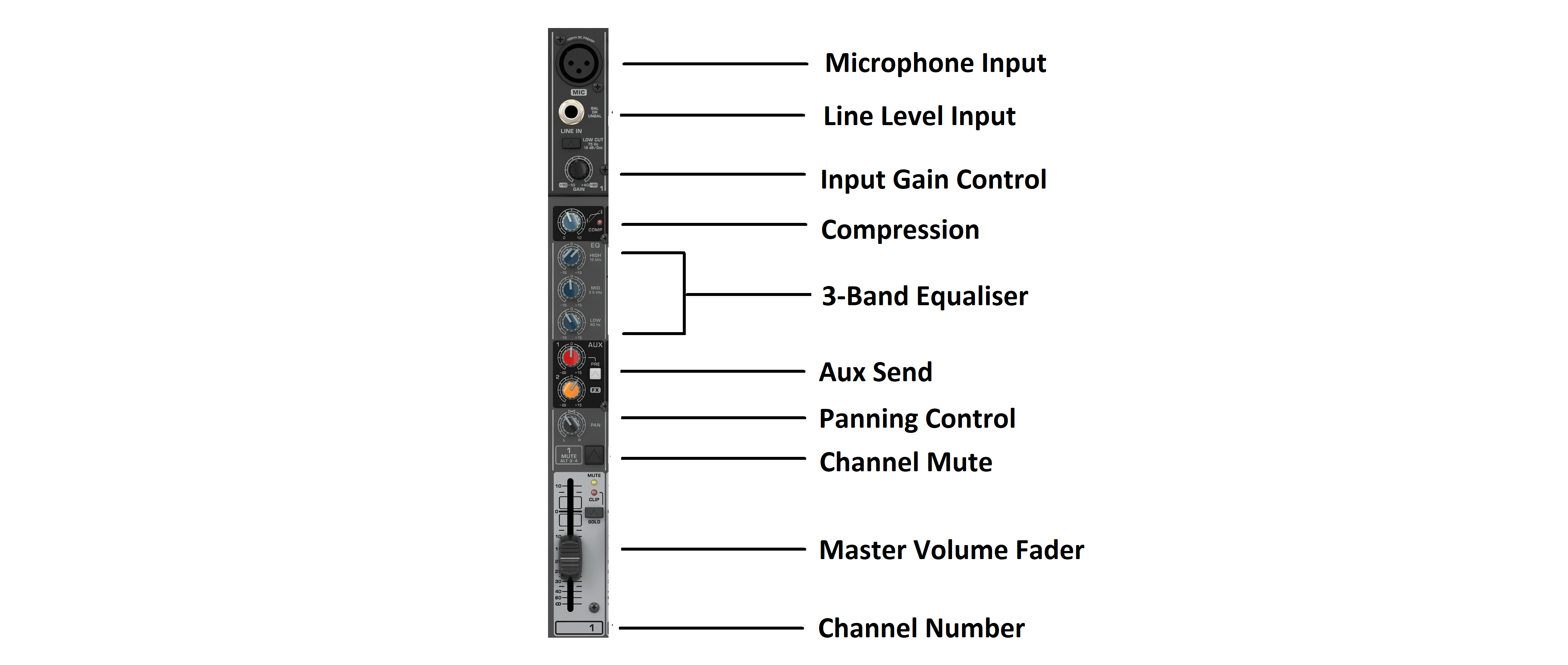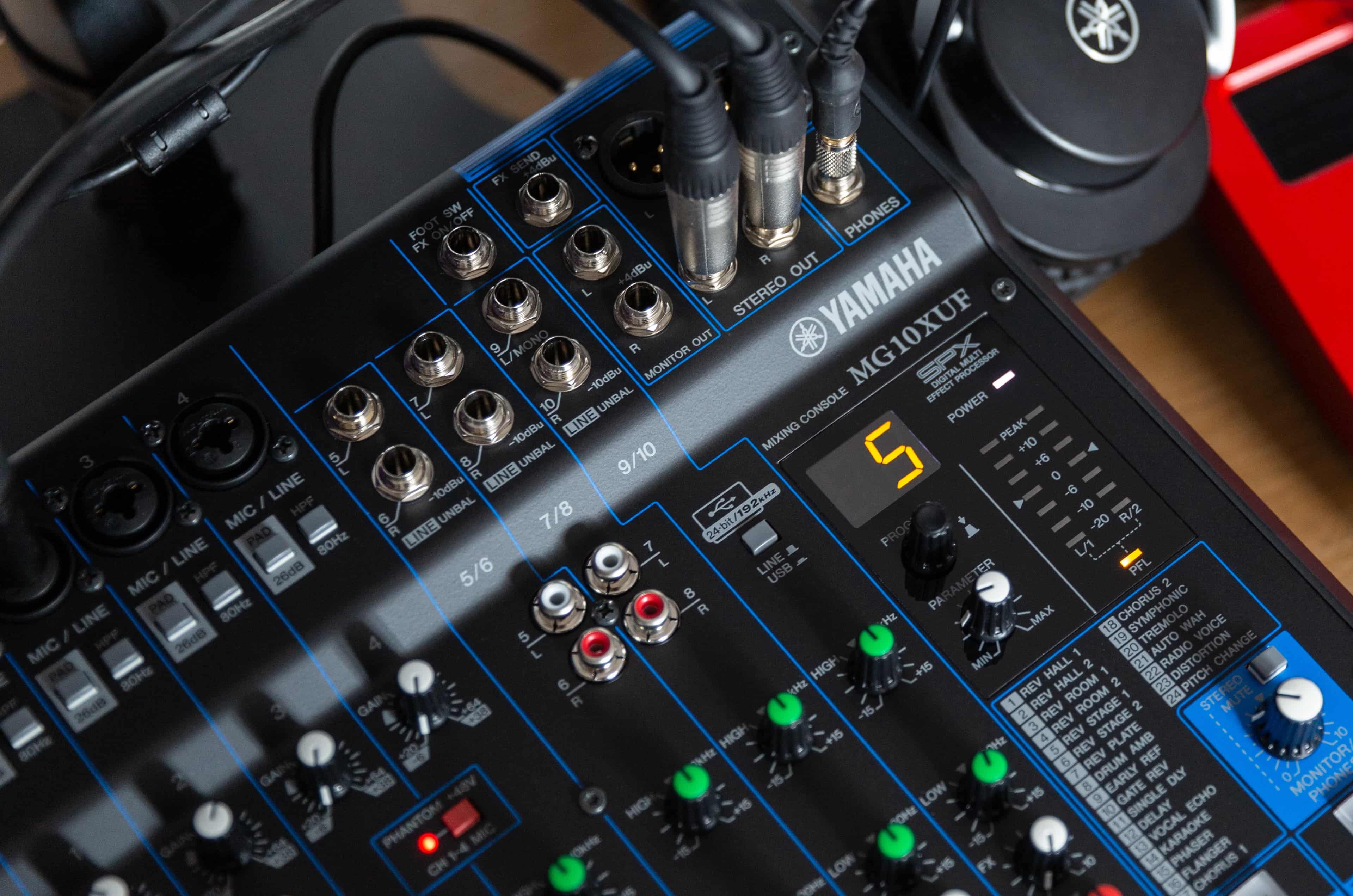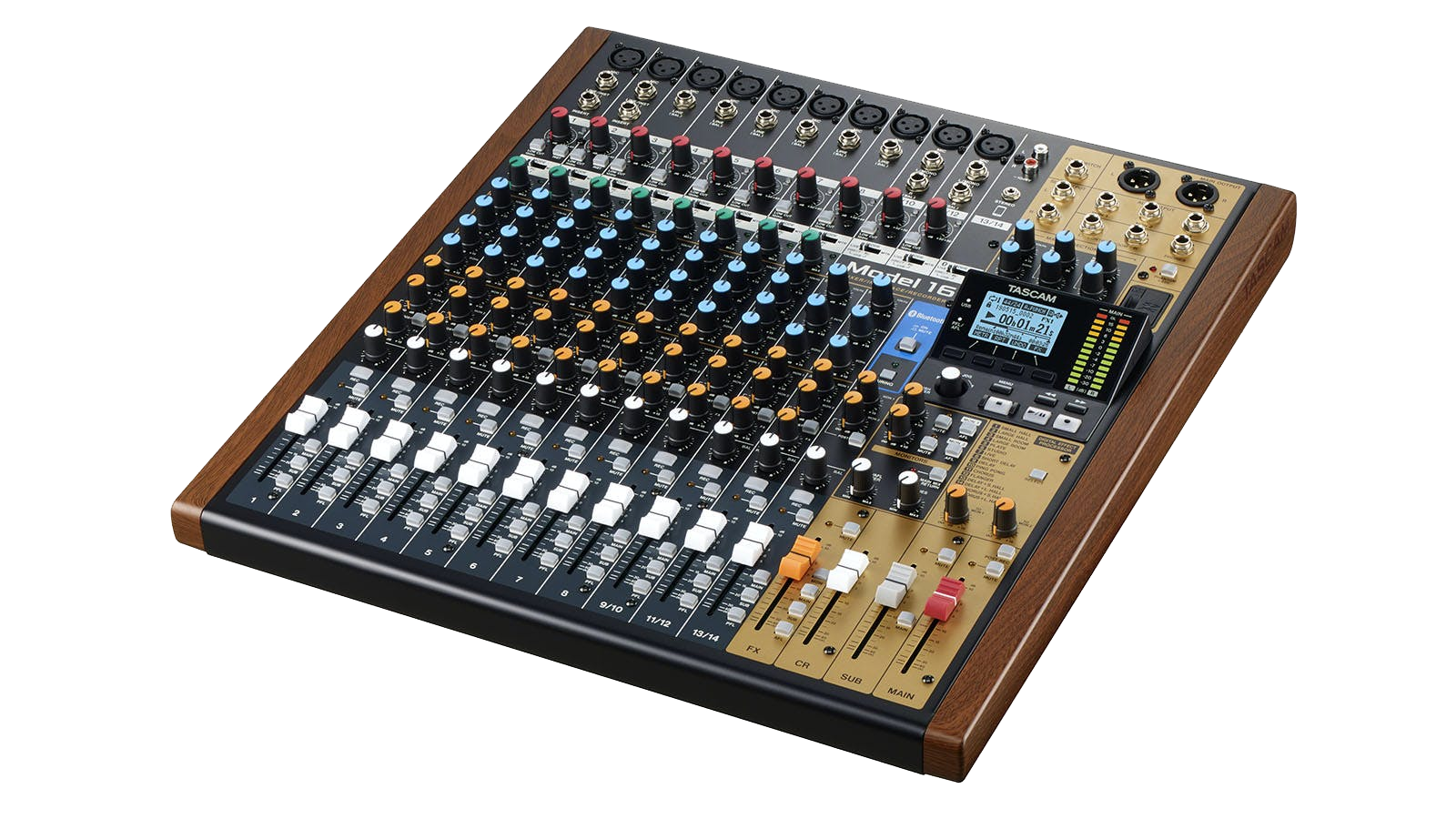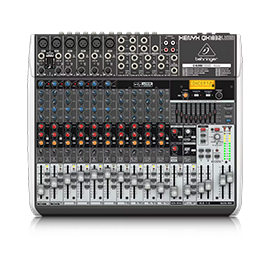In this guide we’ll be covering everything you’ll need to know when picking out the right analogue mixer to suit your needs for live performance.
We’ll be covering all the essentials: what a mixer does, which features impact the price, the main brands to follow and all the tech info you could possibly want!
Click the tiles below to navigate to the relevant section!
Anderton's 5 Minute Guide to Live Analogue Mixers
We’ve broken down everything you’ll need to know when picking out the right live analogue mixer and packed it into a quick 5 minute read!
Studio and live mixers perform similar functions, albeit in different settings. They are both designed to combine all your input signals (microphones, instruments etc.) to be then sent out to front-of-house or external gear. What you plan to do with your mixer and what you plan to hook up to it will dictate the type and quantity of inputs and outputs (I/O) you will need.
The most common type of mixer is the analogue variety – which we’ll be covering in depth today. They’re great for live sound applications due to their hands-on, immediate design. Each control on an analogue mixer handles a single focused function. Every channel, bus, preamp, EQ, and other component is comprised of physical circuitry and it’s very easy to quickly adjust on-the-fly.

Analogue Mixer Overview
The main aspects that differentiate one mixer from another are the user interface, the number of inputs and outputs, and the additional features included on-board. Often the number of features, including your total number of inputs/outputs and effects available, will be reflected in the price of the unit. However, it’s worth noting that the size of the product and the number of features packed on-board don’t always correlate directly to price or quality of a product. Throughout this 5 Minute Guide, we’ll be going over the main on-board features that you’ll want to look out for.
Channel Strip
The channel strips on any mixer are where you’ll find the key controls and inputs/outputs for particular channels. It will feature your microphone and line inputs, your volume control, panning and muting options, and extras such as EQ and auxiliary sends.
Channel strips will feature volume controls in the form of faders or rotary knobs. Faders are nicer to mix with, you can move multiple faders with far more ease than knobs. With 8 fingers you could potentially control 8 faders at once. Rotary knobs on the other hand, only 2 at a time. Faders also offer a visual benefit, it’s easier to see the settings from a distance compared to dials.
Here’s a labelled image of a typical channel strip found on a Behringer mixer to give you an idea of what you might expect to find. All mixers have different channel strips, so bear this in mind when looking for your mixer. You may find it lacks some features shown here, or it may even have some extras!

Channels
Channels can be either mono or stereo and can be designed to accept mic and/or line level signals.
Your mono channels will usually feature a balanced XLR input, for mics. The more mics you’ll need to use at once, the more mono channels you’ll need.
Stereo channels are mainly used for connecting things like keyboards or audio playback. 1 stereo channel will be needed to connect 1 stereo keyboard, for example. Make sure you’ve got enough channels for expansion; you don’t want to be caught short.
A mixer may advertise a specific number of tracks available, let’s say 22 in total for example. 6 of those could be stereo line inputs, while the rest could be mic inputs with a preamp. It’s worth bearing in mind that the number of tracks available won’t all be the same type of connection and won’t be designed to accept the same inputs.
Sometimes you might even see tape returns used for audio playback included in the specs. Don’t get fooled by stereo channels and tape returns! Make sure you have enough mono channels with XLR inputs to do everything you need as they will be your bread-and-butter.
Preamps
As mentioned, mic inputs feature a preamp with gain control to help lift the signal to an appropriate level. The quality of this preamp is highly important - a low-quality preamp will result in a lower quality recording.
Preamp quality is probably one of the most important things when it comes to pro audio. The better preamps, the better the sound, it’s as simple as that. Can If you really want the best vocal sound or you’re using expensive instruments, you’re going to want a good preamp to preserve your high-quality sound.

Aux Sends
An aux send is a type of output used on most live sound and recording mixers. There are two types – pre-fade sends and post-fade sends.
These outputs can be very useful for monitor mixes and effect sends. More aux sends means more control over your monitor mixes and the more aux sends you’ve got available, the more gear you can connect.
A pre-fade send delivers the signal out of the mixer BEFORE it passes through the channel fader. Therefore, you can move the volume fader but it's not going to affect the volume going to that auxiliary unit. You’ll need enough sends to be able to provide a good monitor mix. More pre sends means you can have more advanced monitor mixes.
A post-fade send delivers the signal out of the mixer AFTER it's gone through the fader. This means that when you move the volume fader, that aux send volume is equally manipulated. These are used for sending audio to front of house/PA. They’re also used for sending audio to external effects, although a lot of mixers have built-in effects now.
EQ, Compression & Other Effects
Simple EQ controls, like those found on Hi-Fi systems, may only feature Bass and Treble controls for boosting/cutting the high and low end. This can be handy, however more sophisticated EQs will also have control over the midrange including a sweepable mid frequency which allows you to pinpoint any potential problem areas. The mid-range is especially important with live mixes, as that’s where most of the harmonic content in vocals sits. We’ll be covering the different types of EQ in more detail later in the Ultimate Guide.
On top of EQ capabilities, many modern analogue mixers feature digital effects such as reverb, delay and modulation options which allow you to add extra emotion and space to your sound. For live use especially, it’s well worth getting a mixer that offers on-board effect so you can control everything from the mixer and potentially won’t need any outboard gear, meaning fewer cables and less fuss. Sometimes mixers will be able to store programmable patches, meaning your settings are ready to go next time!
Some analogue mixers also feature an onboard compressor, which can be used to control the dynamic response of your signal and stop it from getting too strong or sounding too weak. They’re especially useful for reining in the transients of drums or a singer with a wide dynamic range, going from soft to loud.
The Best Analogue Mixer Brands on The Market
Like most tech, you generally get what you pay for with established brands. They have a long list of successful products and decades of accumulated experience backing them, so they know what they’re doing.
Buying from a brand with a track record for producing high-quality pieces of kit means you’re almost guaranteed to get something that’ll do the job to a satisfactory level. The top brands know which features users actually want and need to get the job done.
A lot of brands also ‘trickle down’ their latest tech, meaning that the features included in higher end models are likely to find their way to more budget-friendly versions in some capacity.
It’s like buying a BMW – even if you go for the most affordable model they offer, you know you’re still going to get the quality and features you’d expect from the brand. The name carries an expectation for a certain level of quality no matter the price point

Mackie
The story of Mackie starts with a company making a small PA mixer who then grew to become a go-to brand for recording, pro audio, and live sound. Mackie Designs’ debut product, the LM-1602 line mixer, created enough buzz among musicians to inspire founder Greg to get serious and the introduction of the CR-1604 in 1991 put Mackie on the map. Their Onyx Series technology has set a benchmark, bringing great sound within the reach of even the most modest budgets.
Behringer
Behringer believe in producing life-changing products at a price point that gives anyone the ability to fulfil their musical dreams. Founded in 1989, as a fledgling musician and sound engineer, Uli Behringer couldn’t afford the necessary equipment for his own studio. Initially building products just for himself, he soon began supplying them for his friends, too. Thus, Behringer was born, along with its philosophy to continue to produce products at prices that everyone can afford.
Yamaha
Yamaha's history began when its founder, Torakusu Yamaha, repaired a broken reed organ in 1887. Shortly thereafter in 1900, Yamaha began production of upright pianos and over the last century they've expanded into countless different avenues. Today they are a globally iconic brand who continue to produce a vast range of high-quality music equipment, from keyboards and synths, to studio monitors and mixers.
Midas
The explosion of musical talent in 1960’s Britain also gave rise to an electronic musical instrument industry. In 1970, a company called Midas amplification was formed in London, manufacturing transistorised guitar amplifiers and speaker cabinets. A shift in the company’s business took place a couple of years later as they were inspired to look at how the concert sound equipment of the day could be improved upon. For over 40 years, Midas have repeatedly shown award-winning innovation and leadership in the world of high end professional audio, producing landmark products that have defined and shaped the live industry.
Allen & Heath
From bedrooms to boardrooms, houses of worship to iconic festivals, Allen & Heath has set the tone of audio technology for over 50 years. Allen & Heath was in the vanguard of the first wave of great British mixer companies, starting life at the heart of London’s swinging music scene in 1969. In those early days they hand-built mixers for the top bands of the era, including Genesis, Pink Floyd and The Who. Fast forward to the second decade of the 21st Century and as well as touring with the likes of Lewis Capaldi, Bring Me the Horizon and Billie Eilish, the A&H range is used and loved by gigging bands, rental companies, installers, houses of worship, DJs, clubs, broadcasters and studios across the globe.
Soundcraft
Founded in 1973, Soundcraft first made its mark with the launch of the industry-changing Series 1, the first mixing console built into a flight case satisfying the demands of the growing touring band market. Since then it has grown to become an industry leader in digital and analogue consoles for tours, theatres, houses of worship, performance venues and recording applications. Over the years it has introduced a number of iconic consoles such as the Broadway, Sapphyre. GB Series, MH series, Vi Series, Si Series, Signature and Ui. and being twinned with sister console company Studer, has been responsible for industry changing innovations such as the patented FaderGlow and Vistonics user interfaces all designed to make the engineers job and learning - easier.
Alto
Alto Professional was founded in 2000 by a passionate team of audio engineers striving to produce products that delivered superior performance at affordable price points for use in live performance settings. Through the use of modern manufacturing techniques, cutting-edge DSP technology, and sophisticated design, Alto has succeeded in producing a range of products that provide both exceptional performance and exceptional value for the performing musician and live sound engineer. Alto desceribe themselves as a Live Performance Reinforcement company. Not only do they produce tools for the live sound engineer – speakers, amplifiers and mixers – but also tools for the performing musician, including all-in-one PA systems for solo, duo and small group performance settings.
Main Input Types
It’s important to understand the different connection types featured on a mixer so you know where to plug things in. These input/output types will overlap with most other pieces of pro audio gear, including interfaces, so it’s all transferable knowledge.

XLR - Balanced
3-pin XLR inputs are the primary input type for connecting microphones and will feature a preamp used to boost the signal up to a suitable level. They are balanced and may also be capable of receiving a line level signal as is often the case on a lot of outboard gear and interfaces.
A balanced signal allows you to run long cable lengths without signal loss, which can’t do with normal unbalanced guitar cables for example. They also offer great noise reduction capabilities due to the way they’re wired.
TRS - balanced
TRS stands for ‘Tip-Ring-Sleeve’ and features a ¼-inch jack similar to that of an instrument cable. Balanced TRS cables are most used for line level signals, such as sending audio to a monitor. It features the same technology as an XLR cable, but in a smaller space saving format.
Line Level
Line level inputs are designed to receive higher output sound sources such as synthesizers and outboard equipment like compressors. Line level is the level at which most recording/live gear utilises. These inputs often come in stereo, designed to received audio playback or keyboards which are usually in stereo.
Hi-Z
High-Z means high impedance and these inputs are designed to be used with instruments like guitar and bass that have a high output impedance. You don’t see this input type as commonly as the other types mentioned here. A Hi-Z input will allow you to input things like acoustic guitars without having to go in via a preamp or DI box.
Mic Level
To connect a microphone to the mixer, you’ll need a mic level input which will come with a preamp to help boost your signal if needed. You can’t just connect a mic directly into a line level input as line level inputs are designed to receive a higher strength signal.
Make sure you pick a mixer that has enough mic inputs for every microphone that you wish to connect. It’s always worth considering your potential future needs from any piece of gear, so make sure consider you have enough of these input types, if not more than you think you need!
EQ Types
All forms of equalisation serve the same purpose – boost or cut certain frequencies for the signal to sit in a mix as desired. Some types of EQ work differently however:
Shelving EQ
A shelving EQ cuts or boosts frequencies above or below a specified cutoff point. Shelving equalizers are either high-pass and low-pass. Low-pass shelving filters allow all frequencies below a chosen cutoff frequency through, while cutting all the frequencies above the cutoff. A high-pass filter does the opposite, passing all frequencies above the specified cutoff frequency while cutting everything below.
Parametric EQ
Parametric EQ offers continuous control over every parameter. This includes the gain for each frequency band, the centre frequency of the midrange bands, and the cutoff frequency for the low and high bands. Fully parametric EQ offers continuous control of the bandwidth (which determines the range of frequencies affected by certain controls) or control over the Q (which is the ratio of the centre frequency to the bandwidth).
Metering & Monitoring
Meters, usually an array of LEDs, show the strength of the mixer's signals. It's crucial to see that adding all the input signals together doesn't overload the output, which will create unwanted distortion. Peak or clip lights turn on when the mixer senses distortion, letting you know you need to turn something down.
Some mixers feature a screen which displays convenient and accurate metering alongside other important information. If you’re someone who prefers to have a screen available to display all the key info, then this might be something you want included in an analogue mixer.

Phantom Power
Dynamic mics can be plugged straight into a mixer’s mic input and they’re ready to go. Condenser mics, however, require phantom power (usually 48V). Dynamic mics are the most common options for live use generally, but there are plenty of handheld condenser mics designed to be used for live vocals, for example. A mixer than offers phantom power opens more possibilities and expands the range of microphones that will be compatible.
Future Proofing Your Setup
As we always suggest, think ahead if possible. You might be certain that you only need a specific number of I/O at present, but what about in a year’s time? Will your setup expand potentially?
Avoid regretting a purchase and looking for a costly replacement shortly down the road by considering what you may need or want to do in the near future. It’s always better to have access to more options and capabilities than you immediately need, rather than the opposite and finding yourself lacking something you didn’t consider.
More Info
Follow the links below to check out all our products and other great guides to help you find what you need!
If you have any feedback on this guide, or any further questions you'd like to ask us, get in touch and we'll be happy to help!
Shop All Live Analogue Mixers Buyer's Guides Homepage Any More Questions? Contact Us




